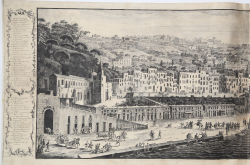






| Reference: | S40663 |
| Author | Ignazio SCLOPIS |
| Year: | 1764 |
| Zone: | Naples |
| Measures: | 2160 x 505 mm |





| Reference: | S40663 |
| Author | Ignazio SCLOPIS |
| Year: | 1764 |
| Zone: | Naples |
| Measures: | 2160 x 505 mm |
Monumental view of the city engraved by Ignazio Sclopis and dedicated to the Viscountess Georgiana Spencer, the name by which it's often identified.
The "Spencer" are the most important views of the city for their size and commitment.
The two views dedicated to Viscountess Spencer take place on three large branches each, with the same height and a difference of about twenty inches in length between them. The smaller one, with the view of Posillipo, shows the entire elevation of the Riviera di Chiaia, of great interest to this part of the city, subsequently much transformed. It is in this sense singular that one of the most important elevations of the city has never received a unitary project arrangement, preserving instead that picturesque, but sometimes trite alternation of facades, typical of a stratified building. Among the buildings, all minutely outlined, stand out the church and the convent of S. Antonio a Posillipo with the ramp leading to the cave of Posillipo, the Fanzago palace Teora Mirelli, the churches of S. Maria della Neve, S. Giuseppe with the primitive facade, S. Maria della Vittoria with the domes and the primitive facade, as well as numerous patrician palaces. In the foreground there is also a lively scene of costume, with knights, carriages, tarantella improvised bickering, fishing scene and the comings and goings of the boats bound for Posillipo, which take land right on the beach of the Torretta. The view has 66 references in the two lateral cartouches, in which the recent eruption of Vesuvius is also remembered. The second, larger view covers, as was now tradition, the entire arc from the tip of Posillipo to the bridge of La Maddalena. It has 68 typographical references in the long lower scroll, accompanied by mythological representations. Here too, but perhaps to a greater extent than in the other, the minute description of the building fabric, decidedly topographical-vedutistic, is of precious help in reconstructing the appearance of places and the history of customs. We mention only, postponing to a specific future illustration, the aspect of the suburb of S. Lucia, with the bulwark, the fountains on the prospect of the sea and the casino Carafa, with the complex of the Cross Palace and the seventeenth-century Arsenal still standing; or to the urban prospect on the port, with the low two-storey buildings destined to customs and administrative offices, the building of the Customs of Flour, already partially modified, the Immacolatella against the Mandracchio - as it was called, with late Greekism, the inner port or Molo piccolo, now closed by a bridge (" Pontenuovo ") for the new Marina road; or the countless improper dwellings, warehouses and boathouses present along the next elevation, covering the city walls, as the Baratta view had already anticipated in the early seventeenth century. Here and there, in addition to very low buildings, one can also observe six-story buildings. On the hill stands out the factory of the Royal Palace of Capodimonte, since a few years seat of the Farnese Musco and, always in the background, below, beyond the forest of domes and bell towers of the old city, we recognize the long bulk of the Albergo dei Poveri, under construction. On the sea parade boats with devices for trawling. Even here the scene is very animated; the crowding of boats, with all their bulky equipment - as well as in the port also along the beach of the Marina, recently arranged by Carlo of Borbone - is so much part of the city that, we can say, the author could hardly have failed to outline it, even if he had wanted to (see Giulio Pane, in La città di Napoli tra vedutismo e Cartografia, pp. 251/253, 109.
In the view of Chiaia, in the center of the picture you can also see the disappeared church and convent of San Leonardo Insula Maris, which, as the name suggests, stood on a small island in the middle of the sea, reached by a small bridge, similar to Castel dell'Ovo. Built in 1028, not being at the time considered of any architectural merit, despite the unusual location and antiquity, it was unfortunately demolished at the end of the 800 to make way for the Via Caracciolo.
"The city is taken from the sea with a lowered point of view compared to the traditional bird's eye view, and with the port facilities in the foreground: as the city appeared to those who came from the sea, and according to the scheme set by Antonio Joli in the departure of Carlo of Borbone from Naples (1759)". (cf. Civiltà del '700 a Napoli, I, p. 20).
Ignazio Lorenzo Ludovico Sclopis (Turin, August 10, 1727 - October 3, 1793) played a major role in the development of landscape painting. From the experience gained for the court in the topographical survey of various strongholds in the Neapolitan area, he developed a new way of understanding the perspective view with great expansion of perspective.
Size: 2160x505 mm (Veduta di Chiaia).
Bibliografia
G. Pane – V. Valerio, La città di Napoli tra vedutismo e Cartografia, pp. 251/253, 109.
|
Draughtsman and etcher of city panoramas. Worked in Naples and Turin, where he died. He is known to have printed 23 views of Turin and the surrounding area and two large views of Naples, now very rare.
|
|
Draughtsman and etcher of city panoramas. Worked in Naples and Turin, where he died. He is known to have printed 23 views of Turin and the surrounding area and two large views of Naples, now very rare.
|